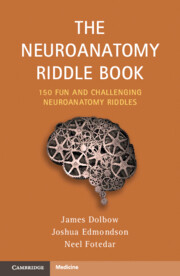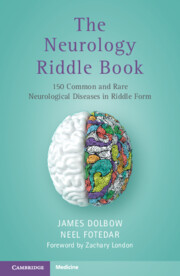Refine search
Actions for selected content:
40 results
High-resolution longitudinal changes in the cortical morphology of youth with family history of bipolar disorder
-
- Journal:
- The British Journal of Psychiatry , FirstView
- Published online by Cambridge University Press:
- 11 September 2025, pp. 1-11
-
- Article
-
- You have access
- Open access
- HTML
- Export citation
Chapter Three - A Structural Foundation
-
- Book:
- The Neuroscience of Language
- Published online:
- 17 April 2025
- Print publication:
- 10 April 2025, pp 42-69
-
- Chapter
- Export citation
Correlating clinical course with baseline subcortical shape in provisional tic disorder
-
- Journal:
- CNS Spectrums / Volume 29 / Issue 6 / December 2024
- Published online by Cambridge University Press:
- 28 November 2024, pp. 652-664
-
- Article
-
- You have access
- Open access
- HTML
- Export citation

The Neuroanatomy Riddle Book
- 150 Fun and Challenging Neuroanatomy Riddles
-
- Published online:
- 22 November 2024
- Print publication:
- 12 December 2024

The Neurology Riddle Book
- 150 Common and Rare Neurological Diseases in Riddle Form
-
- Published online:
- 21 November 2024
- Print publication:
- 05 December 2024
Chapter 3 - Functional Neuroanatomy
- from Section 1 - Essential Background Knowledge
-
- Book:
- The Neuropsychology of Dementia
- Published online:
- 25 October 2024
- Print publication:
- 17 October 2024, pp 34-44
-
- Chapter
- Export citation
Acute Vertebral Artery Dissection in the Context of Bilateral Duplicated Vertebral Arteries
-
- Journal:
- Canadian Journal of Neurological Sciences / Volume 52 / Issue 2 / March 2025
- Published online by Cambridge University Press:
- 03 October 2024, pp. 309-310
-
- Article
-
- You have access
- Open access
- HTML
- Export citation
Chapter 5 - Neuropsychiatric Perspectives on the Biology of Anxiety and Youth Climate Distress
- from Part I - Conceptual Foundations of Climate Distress in Young People
-
-
- Book:
- Climate Change and Youth Mental Health
- Published online:
- 06 June 2024
- Print publication:
- 13 June 2024, pp 93-110
-
- Chapter
- Export citation
Association of hippocampal subfield volumes with prevalence, course and incidence of depressive symptoms: The Maastricht Study
-
- Journal:
- The British Journal of Psychiatry / Volume 224 / Issue 2 / February 2024
- Published online by Cambridge University Press:
- 23 November 2023, pp. 66-73
- Print publication:
- February 2024
-
- Article
-
- You have access
- Open access
- HTML
- Export citation
Brachial Plexopathy Following Minimally Invasive Coronary Artery Bypass Grafting
-
- Journal:
- Canadian Journal of Neurological Sciences / Volume 51 / Issue 3 / May 2024
- Published online by Cambridge University Press:
- 05 June 2023, pp. 463-465
-
- Article
-
- You have access
- Open access
- HTML
- Export citation
Chapter 3 - The Turn to the Brain
- from Part I - Historical Landmarks
-
- Book:
- Cognitive Science
- Published online:
- 10 November 2022
- Print publication:
- 10 November 2022, pp 50-50
-
- Chapter
- Export citation
Chapter 1 - A Brief History of Thalamus Research
- from Section 1: - History
-
-
- Book:
- The Thalamus
- Published online:
- 12 August 2022
- Print publication:
- 01 September 2022, pp 1-26
-
- Chapter
- Export citation
Secondary Gerstmann syndrome, a case report
-
- Journal:
- European Psychiatry / Volume 65 / Issue S1 / June 2022
- Published online by Cambridge University Press:
- 01 September 2022, p. S478
-
- Article
-
- You have access
- Open access
- Export citation
3 - Genetic and Environmental Influences on Chimpanzee Brain and Cognition
-
-
- Book:
- Primate Cognitive Studies
- Published online:
- 28 July 2022
- Print publication:
- 11 August 2022, pp 29-56
-
- Chapter
- Export citation
Examining the common and specific grey matter abnormalities in childhood maltreatment and peer victimisation
-
- Journal:
- BJPsych Open / Volume 8 / Issue 4 / July 2022
- Published online by Cambridge University Press:
- 12 July 2022, e132
-
- Article
-
- You have access
- Open access
- HTML
- Export citation
Chapter 4 - Structural Connectivity of the Insula
- from Section 1 - The Human Insula from an Epileptological Standpoint
-
-
- Book:
- Insular Epilepsies
- Published online:
- 09 June 2022
- Print publication:
- 24 March 2022, pp 31-39
-
- Chapter
- Export citation
A Review on the Surgical Management of Insular Gliomas
-
- Journal:
- Canadian Journal of Neurological Sciences / Volume 50 / Issue 1 / January 2023
- Published online by Cambridge University Press:
- 29 October 2021, pp. 1-9
-
- Article
-
- You have access
- HTML
- Export citation
Symptomatic Internal Carotid Artery Vasa Vasorum Treated With Surgical Occlusion
-
- Journal:
- Canadian Journal of Neurological Sciences / Volume 49 / Issue 1 / January 2022
- Published online by Cambridge University Press:
- 26 March 2021, pp. 118-119
-
- Article
-
- You have access
- HTML
- Export citation
Supranuclear Horizontal Gaze Palsy Following Anterior Internal Capsule Hemorrhage
-
- Journal:
- Canadian Journal of Neurological Sciences / Volume 47 / Issue 6 / November 2020
- Published online by Cambridge University Press:
- 08 June 2020, pp. 822-823
-
- Article
-
- You have access
- HTML
- Export citation
Frontal-striatal circuit functions: Context, sequence, and consequence
-
- Journal:
- Journal of the International Neuropsychological Society / Volume 9 / Issue 1 / January 2003
- Published online by Cambridge University Press:
- 02 March 2020, pp. 103-127
-
- Article
- Export citation
